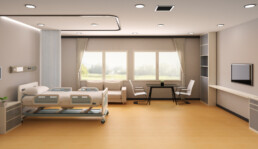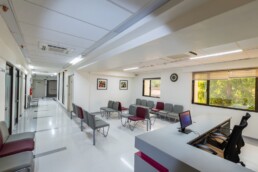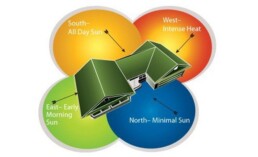Innovative Design Solutions for Senior Care Facilities
As the senior living industry continues to evolve, there is a growing need to incorporate healthcare facility planning and design principles that cater to the needs of older adults. Healthcare architects and designers work together to create safe and aesthetically pleasing environments that feel like home.
Healthcare architecture and design play a crucial role in creating modern senior living facilities that meet the evolving needs of residents. Here are some fundamental building blocks to creating a senior-friendly, safe, and comfortable environment in healthcare facilities.
1, Divide and Conquer
Assisted living facilities are dividing their staff and residents into smaller ecosystems to prevent the transmission of infections from one group to another. This has translated into the design of communal living spaces. For instance, architects are creating smaller vestibules to give each group their amenities, satellite dining areas, lounge space, and private fitness rooms. They also provide secluded rooms to interact with families or visitors.
2. A Taste of the Great Outdoors
Healthcare architects and designers are incorporating biophilic design principles to create environments harmoniously with nature. For instance, indoor potted plants and well-tended lawns help to improve air quality. Research has also shown that exposure to natural light helps patients and residents maintain circadian rhythms while enhancing the quality of sleep and mental and physical well-being.
3. A Hands-Free Approach
The Covid 19 pandemic has accelerated the adoption of hands-free, sensor-based technology. Architects install devices like sensors to enable the touchless opening and closing of doors, walkthrough thermal cameras or temperature scanners at entrances, and automated light and temperature controls. As a result, furniture and common surfaces are becoming more durable and easier to clean.
Check out our blog post on how healthcare facilities are using healthcare architecture and design elements to keep their environments safe and sterile.
4. Home Sweet Home:
Transitioning to an assisted living community is challenging for older adults or their families. According to research, it is projected that by 2040, senior citizens will comprise approximately 22% of the population. This has led to increasing demand for long-term care facilities that can assist with their daily activities. Despite this, most adults (77%) would rather receive care in their own homes.
Visionary Bill Thomas said, “ Let’s go beyond; let’s move past the era of mass institutionalization. Let’s create a model based on one of our oldest ideas: people living in their own homes.”
Healthcare architects and designers are taking inspiration from the hospitality industry and residential home design to create warm, welcoming environments that remind residents of their homes. The challenge is to balance efficient, institution-like settings and cozy, warm, home-like environments that help seniors retain their independence and privacy.
5. Supporting Caregivers
It is essential to consider the staff facilities and senior resident environments for overall design improvement in assisted living facilities. The Covid 19 pandemic has highlighted the need for facilities to ensure the safety and well-being of staff members at the forefront of caring for the residents.
Healthcare architects and designers are incorporating design elements that create a safe and healthy work environment for staff.
6. Leaving No One Behind: The Importance of Inclusive Design
Healthcare architects and designers are also using inclusive design principles to create spaces that are accessible and comfortable for all residents, regardless of their abilities. This includes designing spaces that are easy to navigate, with adequate lighting, contrasting colours, and clear signage.
Doorways and hallways should be wide enough for wheelchairs, and bathrooms should have grab bars, non-slip flooring, and wheelchair-accessible sinks and showers.
The inclusive design also extends to the use of furniture and fixtures that are adaptable and adjustable. For example, height-adjustable dining tables and beds can be lowered or raised to assist with transfers.
7. Beautiful Spaces for Better Living
Art and aesthetics are also essential to healthcare design in senior living facilities. Studies have shown that our environments profoundly influence our cognitive abilities.
“We tend to think we must make things simple for older adults. But this isn’t always true.” Dr. Upali Nanda, HKS Principal and Director of Research.[2]
When senior citizens encounter complex environments, their brain function and neuroplasticity flourish as they engage with different stimuli.
Healthcare architects and designers are incorporating artwork, murals, and sculptures that reflect the local community’s culture and history to create a welcoming and aesthetically pleasing environment.
Check out our detailed blog on how design elements in a healthcare environment can help improve mental health.
Conclusion
As healthcare designers, we understand that creating safe and aesthetically pleasing environments that feel like homes for older adults is essential. Incorporating senior-friendly elements into healthcare facility planning and design principles is vital to cater to the needs of older adults and their families.
Kshititi Nagarkar, Shree Designs
Related Posts
Designing Healthcare Facilities,Infographic
Blueprint for Healthcare Design
From room dimensions to lighting levels, every detail matters in healthcare design. At Shree…
Designing Healthcare Facilities
Building Better Day Surgery Centres
Efficient care, happier patients, and smarter workflows - this is what defines a successful…
Designing Healthcare Facilities,Infographic,Project Management
Designing Healthcare Spaces That Truly Heal
From concept to completion, every medical space we design prioritizes patient flow, staff…
Designing Healthcare Facilities
The Business of Wellness
In the $1.8 trillion wellness industry, first impressions matter. Patients don’t just choose a…
Designing Healthcare Facilities
Efficient Hospital and Clinic Design
India’s emerging cities are growing rapidly, creating an urgent demand for accessible and efficient…
Designing Healthcare Facilities
Creating Calming and Confidential Spaces for Fertility Clinics
As the demand for fertility treatments grows, the architecture of these clinics plays a vital role…
Designing Healthcare Facilities
Designing the Perfect Hospital Pharmacy
Hospital pharmacies are the backbone of seamless patient care. From efficient workflows to secure…
Designing Healthcare Facilities
Preventive Care Facility Design Strategies
With preventive care emerging as the future of healthcare, this post outlines key architectural…
Designing Healthcare Facilities
Thermal Comfort Decoded
Thermal comfort plays a critical role in patient recovery, staff productivity, and overall…
Designing Healthcare Facilities
Building for Tomorrow: The Imperative of Adaptable Healthcare Design
Healthcare facilities need to be as dynamic as the industry itself. Traditional, rigid designs can…
Designing Healthcare Facilities
Designing Single Speciality Healthcare Centres
As single-speciality centres grow, their design needs become more specific, calling for tailored…
Designing Healthcare Facilities
Designing a Dental Clinic for Success
Providing quality dental care is not just about the technical elements of the treatment. It's also…
Designing Healthcare Facilities
3 Essential Design Features for Intensive Care Units
ICUs are not just limited to single units housing all critical patients. If the facility has…
Designing Healthcare Facilities
3 Lessons Learned While Building a Cardiac Cath Lab
Cardiac care design is moving at the sound of a new beat! The number of Cath labs in India has…
Designing Healthcare Facilities
5 Essential Elements of Healthcare Design
Design makes a significant impact on the delivery of care for both healthcare providers and…
Designing Healthcare Facilities
5 Best Ways to Create Healing Spaces for Kids
Designing spaces in healthcare facilities tailor-made for children is a lesson in balance! A…
Designing Healthcare Facilities
Top 5 Trends in Healthcare Design
Design can make all the difference when it comes to improving patient care. From a patient’s point…
Designing Healthcare Facilities
The Architectural Design of Hospital Facilities
Shree Designs designed and executed many efficient and safe healthcare setups in the middle of the…
Designing Healthcare Facilities
Dauntless Designers
Healthcare Radius in its 7th Anniversary Special issue in October 2019, featured a "power list of…
Designing Healthcare Facilities
The changing face of healthcare design
After completing a decade in designing healthcare projects, Kshititi Nagarkar, principal architect,…
Designing Healthcare Facilities
Thumb Rules for Planning and Designing of Hospitals
Traditional rules of thumb in healthcare planning have changed. Once-accepted rules can now be the…




















